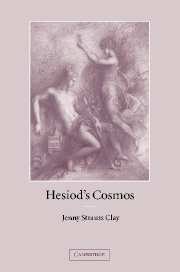Book contents
- Frontmatter
- Contents
- Preface
- Acknowledgments
- List of abbreviations
- Introduction
- 1 Orientations: the Theogony
- 2 Orientations: the Works and Days
- 3 Overtures
- 4 The origins and nature of mankind
- 5 The two Prometheuses
- 6 Perspectives on gods and men
- 7 Hybrids
- Conclusion: Hesiod and Calchas at Aulis
- Bibliography
- Indexes
1 - Orientations: the Theogony
Published online by Cambridge University Press: 04 August 2010
- Frontmatter
- Contents
- Preface
- Acknowledgments
- List of abbreviations
- Introduction
- 1 Orientations: the Theogony
- 2 Orientations: the Works and Days
- 3 Overtures
- 4 The origins and nature of mankind
- 5 The two Prometheuses
- 6 Perspectives on gods and men
- 7 Hybrids
- Conclusion: Hesiod and Calchas at Aulis
- Bibliography
- Indexes
Summary
Whence each of the gods came into being, or whether they always existed, and what their functions were, the Greeks did not know until recently – yesterday, so to speak. Hesiod and Homer … were the ones who made a theogony for the Greeks and gave the gods their names and distinguished their honors and skills and indicated their forms.
(Herodotus 2.53.1–2)Herodotus’ statement is of course not literally true; yet neither is it completely false, for it contains a deeper truth. Homer did not invent the gods, but the images of the gods contained in his poetry were the ones that continued to dominate the Greek imagination. Homer reveals the gods in their interactions with men, or rather, with those grand human beings of the past, the heroes, with whom the gods consorted more intimately and more openly than they did subsequently. From Homer we can learn much about the functioning of the Olympian pantheon, the prerogatives and honors (timai), and characteristic modes of action of each individual god under the supreme authority of Zeus, who is both king and father of them all.
Homer alludes in passing to various stories about the earlier history of the gods before the stabilization of the Olympian order, and his narrative presupposes a familiarity on the part of his audience with such tales, but he has no interest in being either exhaustive or systematic.
- Type
- Chapter
- Information
- Hesiod's Cosmos , pp. 12 - 30Publisher: Cambridge University PressPrint publication year: 2003



